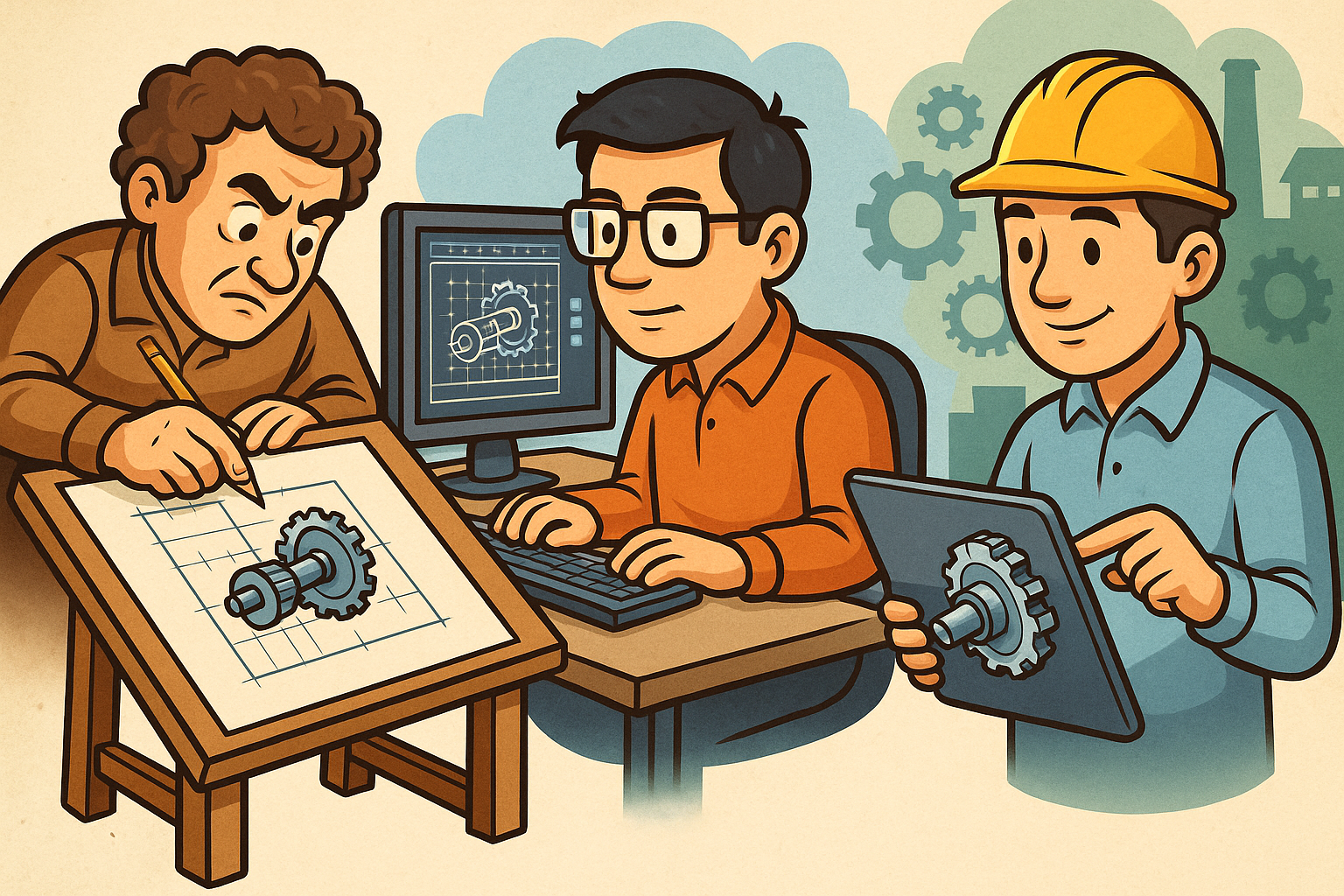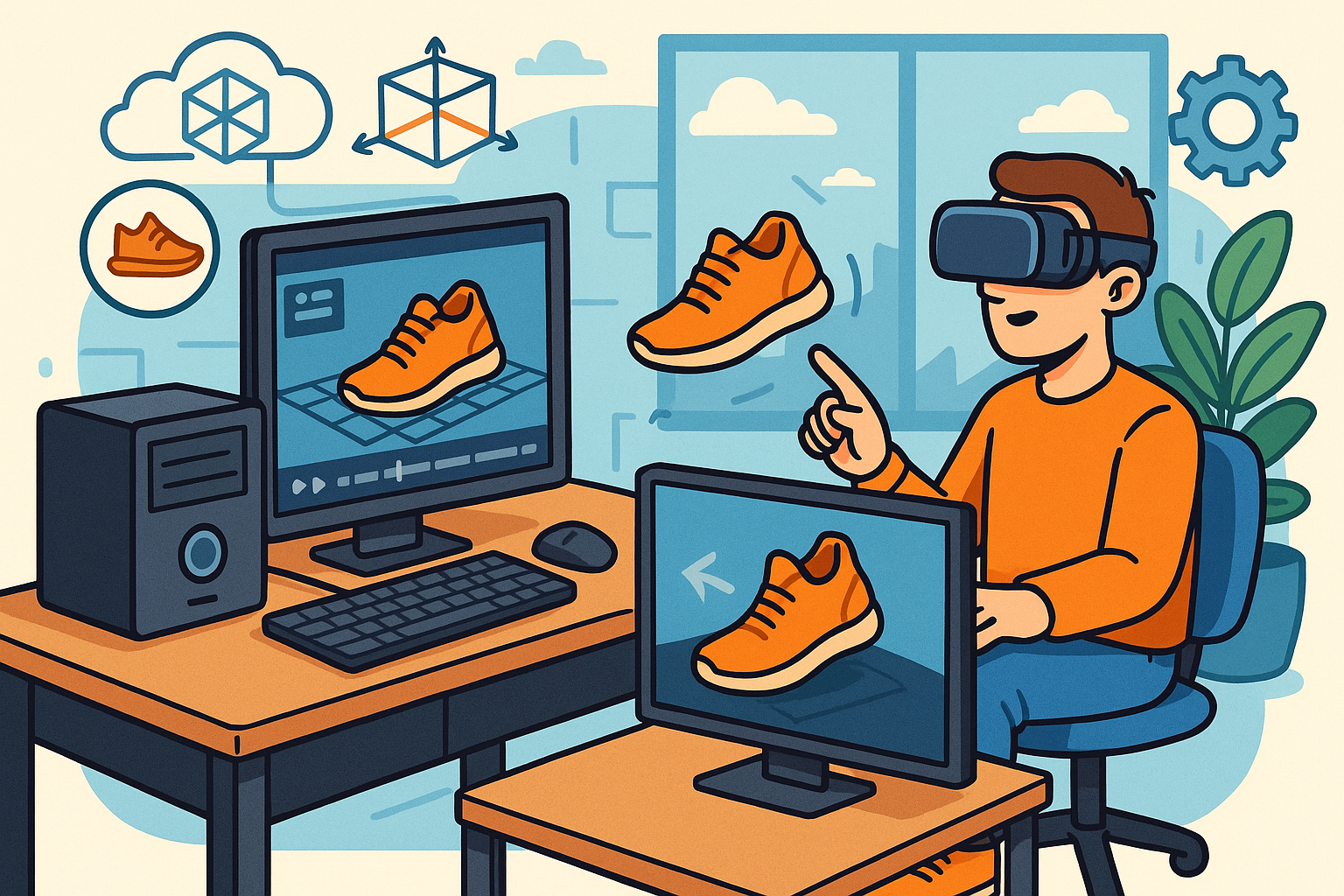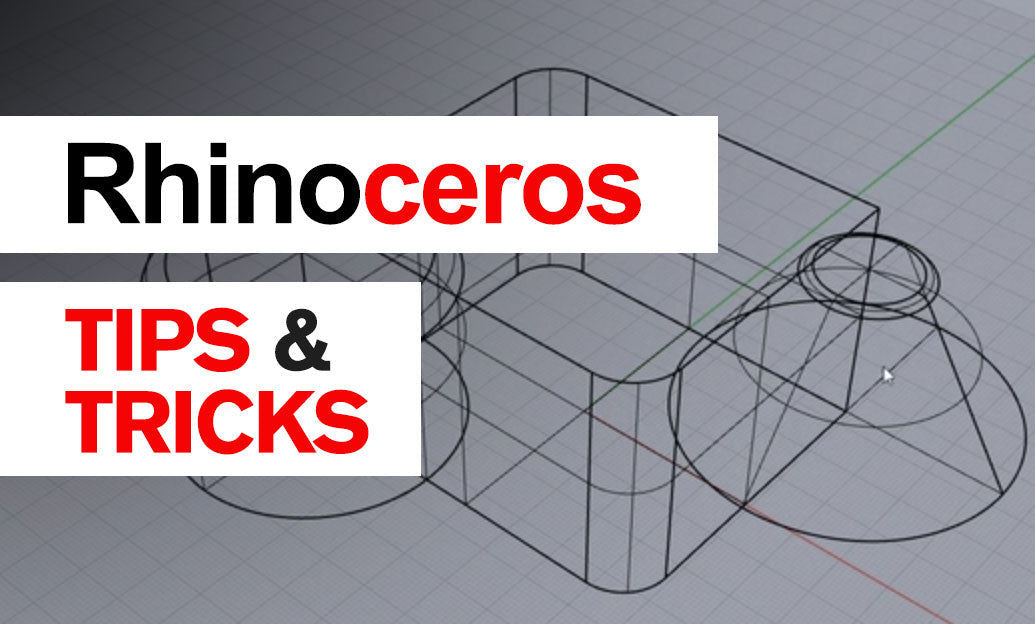Your Cart is Empty
Customer Testimonials
-
"Great customer service. The folks at Novedge were super helpful in navigating a somewhat complicated order including software upgrades and serial numbers in various stages of inactivity. They were friendly and helpful throughout the process.."
Ruben Ruckmark
"Quick & very helpful. We have been using Novedge for years and are very happy with their quick service when we need to make a purchase and excellent support resolving any issues."
Will Woodson
"Scott is the best. He reminds me about subscriptions dates, guides me in the correct direction for updates. He always responds promptly to me. He is literally the reason I continue to work with Novedge and will do so in the future."
Edward Mchugh
"Calvin Lok is “the man”. After my purchase of Sketchup 2021, he called me and provided step-by-step instructions to ease me through difficulties I was having with the setup of my new software."
Mike Borzage
Design Software History: The Evolution of Automotive Design Software: From Manual Craftsmanship to Digital Innovation and Collaboration
July 24, 2025 11 min read


This brief introduction serves solely to provide context without delving into extraneous details. In the early days of automotive design, methods relied heavily on manual craftsmanship and physical model-building, setting the stage for a revolutionary shift to digital processes. The evolution witnessed a gradual yet unstoppable move from hand-drawing designs to the intricate and precise world of computer-aided design. With each phase, the automotive industry embraced technological advances that redefined design methods, ultimately converging engineering precision with creative aesthetics. This article explores the transformative journey from rudimentary sketch practices to modern digital platforms, highlighting key innovations, influential institutions, and breakthrough software that have collectively reshaped automotive design. Despite the brevity of this introductory note, it lays the groundwork for a detailed examination of historical milestones, influential personalities, and landmark developments in design software. The following discourse is organized into several detailed sections that meticulously chart the evolution of design technology, ingeniously bridging early manual practices with today's sophisticated CAD systems.
Early Beginnings in Automotive Design Software
The dawn of automotive design was characterized by an era in which designers relied on hand-drawing, physical model crafting, and heuristic methods to visualize and refine vehicle forms. Designers, engineers, and craftsmen used pencils, markers, and drafting tables to execute precise sketches, while clay models and wooden prototypes enabled a tactile and experimental approach to automobile styling. In these early days, innovation was tightly linked with personal skill and artisanal precision, as design iterations were manually executed and assessed for both aesthetic appeal and functional viability. Traditional practices were substantially influenced by the constraints and affordances of the available tooling and physical materials. Designers frequently worked with rudimentary tools to trial complex curves and shapes, relying on both their intuition and an in-depth understanding of mechanical principles to balance form and function. Pre-digital automotive design methods were rich in tradition yet fraught with limitations, such as the inability to quickly adjust designs or simulate real-world stresses under operational conditions.
Pre-Digital Methods in Automotive Design
In an era dominated by empirical techniques, physical models played a fundamental role in automotive design. Designers meticulously built scale models using clay, wood, and metal, each serving as a three-dimensional canvas on which creative ideas could be physicalized. These models, while impressive in their craftsmanship, had inherent constraints with respect to precision and reproducibility. The iterative process was both time-intensive and costly, often necessitating extensive labor to correct and refine subtle design flaws. Moreover, the lack of advanced mathematical tools and computational aids meant that aerodynamic and structural analyses were performed manually, relying on physical wind tunnel testing and rudimentary calculation methods. Despite these challenges, the passion and ingenuity of pioneers in the field led to several breakthroughs that laid the foundational ideas for later digital transformations. Some of these early innovators demonstrated a unique ability to translate aesthetic vision into practical design, a hallmark that would eventually be integrated into the digitized design tools that followed.Introduction of Computer-Aided Design in Automotive
The arrival of computer-aided design (CAD) heralded a monumental transformation in the automotive industry. Initially introduced as a means of augmenting traditional drafting techniques, CAD allowed designers to create models with considerably higher accuracy and to revise their work rapidly. Early systems, though rudimentary by today’s standards, began to incorporate basic two-dimensional and eventually three-dimensional interfaces that eased the visualization of complex automotive structures. Pioneering companies and research institutions played critical roles by adapting existing computing technologies—originally developed for military and aerospace applications—for automotive design purposes. Early adopters realized that computer simulations and digital representations could streamline design processes, thus reducing the time and resources expended on building physical prototypes. This nascent integration of digital technology revolutionized the design process by enabling multiple iterations and letting designers scrutinize minute details from various perspectives. As a result, the industry quickly recognized the immense value of leveraging digital tools to achieve both creative freedom and engineering precision. A range of industries, including aerospace and defense, also contributed valuable insights, as the precision demands in those fields were similar to those required in automotive design.Role of Institutions and Innovators in Adapting CAD
Institutions and visionary innovators were pivotal in refining and propagating the use of CAD within automotive design. The synergy between academic research and practical engineering solutions led to an accelerated development of digital drafting tools. Researchers and engineers at universities and specialized research centers collaborated closely with the emerging software companies, pushing the envelope in both hardware performance and algorithm efficiency. This collaboration also catalyzed the integration of simulation techniques that would later be used to test and validate designs digitally. Among the early trailblazers were engineers with backgrounds in both mechanical design and computer science, individuals who recognized the limitless potential of blending computational power with creative design practices. Their work laid the foundation for subsequent generations of automotive designers to utilize increasingly sophisticated CAD systems. Moreover, the cross-pollination of ideas from military and aerospace sectors—where precision and performance were paramount—further reinforced the capabilities of these digital platforms. Despite initial challenges, the unwavering commitment to innovation ensured that CAD quickly evolved beyond a mere digital drafting tool to become an indispensable component in automotive product development.Influence of Military and Aerospace Developments
Early military and aerospace advancements played an influential role in shaping the evolution of CAD technology, particularly as the automotive industry sought to borrow and adapt these robust methodologies. Design approaches refined in high-stakes environments allowed for the creation of systems capable of simulating complex aerodynamic properties and structural integrity. These systems, though initially designed for flight vehicles and military hardware, provided crucial insights into managing performance under extreme conditions. The rigorous testing and simulation processes developed for aerospace applications offered a blueprint for automotive engineers, who, in turn, incorporated these techniques to enhance vehicle safety and reliability. The resulting cross-disciplinary influences were evident in the precision of early CAD systems and the methods used to treat material properties and dynamic stress. As automotive design software progressed, the lessons learned from military and aerospace sectors remained deeply embedded in the workflows, ensuring that safety, performance, and efficacy remained at the forefront of innovation. This integration not only fortified the design process with enhanced analytical capabilities but also paved the way for future developments in simulation-intensive automotive design environments.Pivotal Technological Milestones
In the evolution of automotive design software, various technological milestones have consistently acted as catalysts for transformative change. The journey from basic 2D drafting systems to sophisticated 3D solid and surface modeling platforms marks a period of relentless innovation driven by both necessity and opportunity. This era witnessed the emergence of advanced features that not only heightened the fidelity of design representations but also enabled dynamic interactions with the design environment. One of the most significant breakthroughs in this domain is the introduction of parametric design, a methodology that revolutionized automotive body styling by allowing automatic recalculations of dimensions and geometries based on user-defined constraints. These breakthroughs were propelled by the relentless efforts of industry leaders and technology companies such as Dassault Systèmes, Siemens, and PTC, which embraced innovation to improve user interfaces, simulation tools, and real-time rendering capabilities. Consequently, automotive design software underwent a paradigm shift as designers began to leverage simulation data for aerodynamic and safety analyses—a critical factor in modern automotive engineering. The integration of simulation functionalities with design platforms meant that designers could now perform iterative testing on vehicles without the need to produce physical prototypes.
Transition from 2D Drafting to 3D Modeling
The transition from two-dimensional drafting to three-dimensional modeling signified a monumental leap in design capability. Early 2D drafting tools, though groundbreaking at the time, were inherently limited in representing the true form and spatial relationships within a design. The advent of 3D solid and surface modeling eliminated these constraints by enabling designers to visualize and manipulate digital models in space with unparalleled accuracy. These developments introduced concepts such as extrusion, filleting, and parameterization, allowing for smoother transitions and more efficient design adjustments. As a result, engineering teams could rapidly iterate on designs, identifying potential issues well before the manufacturing stage. Designers benefited from enhanced capabilities to simulate physical interactions under various environmental conditions. This leap not only enriched the creative process but also laid a technological foundation that would support further innovations in simulation-based analyses and virtual prototyping. Among the enhanced functionalities, the seamless translation of design modifications into recalculations of aerodynamic profiles and structural parameters was particularly transformative, setting the stage for subsequent engineering advancements in both performance and efficiency.Parametric Design and Software Breakthroughs
The introduction of parametric design was a watershed moment in automotive design software history. Through parametric design, every element of a design model became dynamically linked, meaning that adjustments to one parameter automatically recalculated dependent elements across the entire model. This innovation bolstered design precision by reducing manual recalculation errors and enhancing consistency during revisions. Major software companies such as Dassault Systèmes, Siemens, and PTC drove forward this technology by integrating robust parametric capabilities into their platforms. Their contributions played an instrumental role in standardizing processes that allowed designers to explore innovative forms with enhanced agility. Moreover, the parametric approach rendered the design process far more adaptive, permitting swift modifications in response to market shifts and regulatory requirements. Several key software breakthroughs during this era included the integration of finite element analysis (FEA) and computational fluid dynamics (CFD) into the design environment, which further emphasized simulation as an integral part of the automotive design lifecycle. The evolution of these user interfaces, with their emphasis on real-time interaction and intuitive controls, facilitated rigorous aerodynamic and safety analysis prior to physical testing. This convergence of design and simulation enabled manufacturers to optimize vehicle performance under variable conditions, thereby accelerating time-to-market while ensuring high levels of safety and quality.Integration of Simulation and Real-Time Rendering
The final leap in this phase of technological evolution involved the seamless integration of simulation tools and real-time rendering features into automotive design software. This integration allowed designers and engineers to simulate complex interactions, such as airflow dynamics, structural stresses, and thermal effects, without ever leaving the digital environment. Enhanced real-time rendering tools provided a visual assessment of the model under simulated conditions, offering instant feedback that significantly improved the iterative design process. This level of integration advanced automotive design by extending beyond mere visualization; it actively informed decision-making regarding materials, safety mechanisms, and performance enhancements. Designers could now work in parallel with simulation engineers, ensuring that every nuance of the vehicle’s design was tested under realistic conditions. The result was an efficient digital ecosystem where design, simulation, and validation coexisted harmoniously. Consequently, the automotive industry witnessed a reduction in costly missteps during the manufacturing phase, while overall product quality was elevated. With advancements in additive manufacturing and rapid prototyping further integrated into these workflows, the automotive sector set a new benchmark in efficiency and innovation.Shaping the Automotive Industry and Design Processes
The evolution of automotive design software over the decades has not only enabled more precise and innovative vehicle designs but has also fundamentally redefined the entire product development lifecycle. The integration of digital tools in automotive design has catalyzed a convergence of design, engineering, and manufacturing processes, thereby spawning a paradigm shift in how vehicles are conceptualized, refined, and brought to market. Today’s design software platforms offer sophisticated functionalities that bridge the gap between creative vision and engineering feasibility, facilitating improved communication and efficient collaboration among multidisciplinary teams. Cloud-based platforms, real-time updates, virtual prototyping, and collaborative environments have collectively accelerated the design process, which once spanned many months, into mere weeks. The widespread adoption of these technologies has not only enhanced overall efficiency but also sparked a wave of innovation in material simulation and additive manufacturing techniques that cater to both enhanced performance metrics and sustainability goals. The automotive industry now leverages these advanced software systems to devise efficient safety protocols, analyze aerodynamic performance, and simulate vehicle dynamics under diverse stress scenarios, all within an integrated digital framework that minimizes iteration cycles. Digital collaboration has proven to be the cornerstone of modern vehicle design, enabling stakeholders from disparate geographical locations to engage in real-time problem solving and iterative refinement of vehicle models.
Transformation of Product Development Cycles
A major impact of contemporary automotive design software is observed in the transformation of product development cycles. Where traditional methods required extensive time for prototyping and physical testing, digital platforms now facilitate rapid iterations and early error detection. Designers, engineers, and manufacturing experts can now concurrently work on shared digital models, thereby eliminating silos and significantly reducing the need for redundant workflows. Advanced simulation tools, capable of predicting outcomes of various design modifications, play a critical role in this transformation; these tools enable a more robust, data-driven design process that preempts potential issues during production. A combination of real-time feedback from simulation engines and cutting-edge visualization systems allows for a more dynamic assessment, resulting in a final product that is both innovative and reliable. The reduction in lead times and overall costs associated with digital design has allowed manufacturers to better respond to market dynamics and consumer demands. This synergistic approach, which blends artistry with analysis, has become instrumental in optimizing both production efficiency and vehicle performance.Enhanced Collaboration and Future Trends
In today’s competitive automotive landscape, collaborative digital ecosystems have become increasingly indispensable. Cloud-based technology now supports virtual design meetings, seamlessly integrating insights from various departments such as engineering, design, and manufacturing. Notably, virtual prototyping has emerged as a key facilitator of efficient collaboration, enabling teams to simulate complete vehicle behavior before investing in costly physical models. The modern design software environment incorporates advanced materials simulation modules, further supporting the integration of cutting-edge technologies like additive manufacturing and hybrid materials analysis. This multi-faceted approach has empowered manufacturers to embrace new challenges such as electric and autonomous vehicle design, where the interplay of sensors, control systems, and mechanical components demands a delicate balance between artistic vision and engineering rigor. The synthesis of these elements has led to a cyclical feedback mechanism that continuously drives industry standards upward. With forward-looking strategies that anticipate emerging trends, automotive design is poised to further capitalize on revolutionary technologies such as artificial intelligence and machine learning. These breakthroughs promise to refine predictive modeling even further, ensuring that future vehicles meet both performance and sustainability objectives while pushing the boundaries of design innovation.Conclusion
In reflecting upon the transformative journey from early CAD implementations to today’s sophisticated design platforms, it becomes evident that automotive design software has evolved in parallel with broader technological and industrial shifts. The industry has witnessed a remarkable progression from hand-drawn sketches and clay models to intricate digital simulations that enable the design of safer, more efficient, and aesthetically refined vehicles. This evolution is a prime example of the interplay between technological innovation and the relentless demands of modern automotive production. Modern CAD systems not only facilitate design precision and shorten product development cycles but also serve as engines of innovation that drive industry standards upward. The implementation of parametric design, integrated simulation tools, and real-time rendering has redefined the vehicle design process by effectively merging creative and technical aspects into a single coherent workflow.
Summary and Forward-Looking Perspective
Throughout its history, automotive design software has served as both a reflection and an enabler of technological progress, exemplifying how industry challenges can foster groundbreaking advancements. Key contributions from software giants such as Dassault Systèmes, Siemens, and PTC have catalyzed critical developments that continue to shape the way vehicles are designed and produced today. As the industry moves forward, further integration of cloud-based collaboration, additive manufacturing, and advanced simulation will be indispensable in tackling emerging challenges. Looking ahead, the shift towards electric and autonomous vehicles is expected to spur even more innovative iterations in design software. The challenges and opportunities ahead suggest a future where digital design tools will be even more closely integrated with production processes, ensuring that the automotive industry remains at the forefront of technological and design innovation. In this evolving landscape, the principles established in the early days of CAD continue to influence modern workflows, as the automotive sector consistently leverages past innovations to propel future advancements, thereby maintaining a clear trajectory of progress and excellence.Also in Design News

Design Software History: Historical Evolution of Design Software in Mechanical Engineering: From Manual Drafting to Digital Integration and its Impact on Education and Industry
July 25, 2025 9 min read
Read More
Real-Time 3D Rendering: Transforming Product Visualization with Interactive Immersion
July 25, 2025 7 min read
Read More
Rhino 3D Tip: Maximizing 3D Modeling Efficiency with the ScaleExtrude Command in Rhino 3D
July 25, 2025 3 min read
Read MoreSubscribe
Sign up to get the latest on sales, new releases and more …


